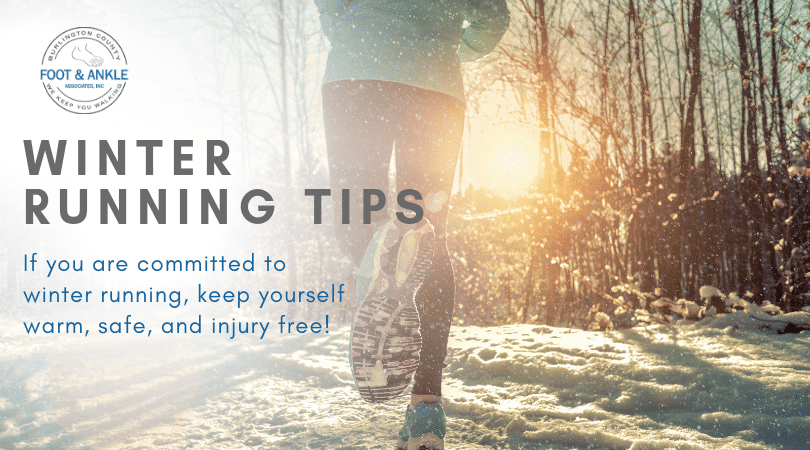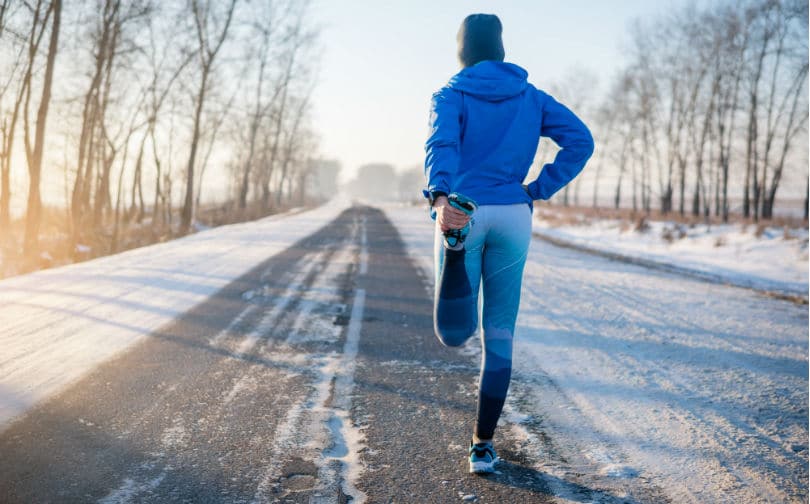Don’t Slip Up on Winter Running
Once they start running, some people just don’t wish to stop. That’s true even once winter rears up and turns our towns into an ice rink.
Sure, there’s always a treadmill, but some runners would rather risk getting splashed by a snowplow than grind away on of those machines all winter.
That’s understandable. Some people just want to feel the wind in their face, even if it comes with a chill.
But winter running with ice and snow in the picture requires a few changes in approach compared to the clear, warm trails of summer. You don’t want a winter run to result in an injury or wreak other forms of havoc on your feet and ankles!
Whether you’re venturing out into the cold for the first time or are a grizzled veteran of the frosty trails, keep these winter running tips in mind.
Wear the Right Shoes and Socks
You had to see this one coming first from us.
Having the right shoes for running in general is vital, of course. But shoes for running in winter must accommodate both your feet and potential conditions.
Many running shoes designed for warmer running will have an upper portion made of mesh. This will be a huge downfall if you have to step through any slush or higher snow on your route, as it won’t stop water from entering your shoes.
An upper portion made of Gore-Tex is ideal. Barring that, opt for as little mesh as possible. Your shoes should be water resistant while still fitting well and still properly supporting the particulars of your gait and foot structure. A trained sports store or shoe store associate should be able to help you find your best match.
Having the right shoes doesn’t mean you should neglect your socks, though! The best socks for winter running will help keep your feet warm while still wicking moisture away from them.
Wool is a good material to look for in winter running socks, but you will also want to seek pairs that are relatively lightweight and not going to slide against your foot throughout a run. Wonder material Gore-Tex can also be found in socks, but they are rather expensive.
Give Yourself Traction When Needed
The conditions on your route can vary from day to day. Sometimes that sidewalk will be clear; other times it will be covered in packed snow with a shiny glaze of ice.
Shoes with cleats exist, but they will get messed up if you’re consistently using them against pavement (probably doesn’t make the pavement look so great, either).
Portable cleats such as Yak Trax are likely a better fit for changing conditions. They are small enough to keep in your pocket and slip over your running shoes when necessary.
Spend Some Extra Focus on Warming Up
Warming up before a run is recommended no matter the temperature outside, but our bodies need extra time to prepare when it’s cold out. This tends to be even truer if a run is happening first thing in the morning and we haven’t had much chance to move around yet.
If you have short calf muscles or other special factors in your feet and ankles you address through stretching, spend a little extra time working on them before you really start going. And once you do start on your route, spend at least 5 minutes in a brisk walk before ramping up to a run. Making sure your body is well warmed up is a good way to help prevent sports injuries.
Aim for Lighted Running, When Possible
It already feels like we spend too much of winter in the dark. Getting out when daylight is available is good for our bodies. It’s also safer, making you more visible to traffic.
Of course, our lives may not always make daylight running possible. Bright and reflective gear will be your friend while night running, and don’t be afraid to use headlamps or flashlights, either. You’ll be better able to see what’s in front of you, and people will be able to see you just as well. Both are extremely important.
(And if you want to wear a portable string of Christmas lights while you run, nobody’s going to stop you, either.)
Don’t Be Afraid to Use a Treadmill (Sometimes)
Let’s face it: sometimes the weather is just going to be too terrible to get out there. Instead of risking hypothermia or a nasty spill, a treadmill is going to be your best choice.
But how do you run on the treadmill without it sucking the life from your runs? Make the treadmill a good opportunity to focus on interval running. Changes in pace keeps things more interesting and focused.
Of course, having your favorite tunes or a season of a show to watch on your tablet doesn’t hurt, either.
Don’t Overdress
A common rookie mistake for beginning runners is wrapping themselves up in a bunch of layers before heading out, then dying to shed them all once they are well into their run.
The general rule of thumb is to dress as though the temperature is 20 degrees warmer than it actually is. You will be a bit cold when you start, but your natural body heat will make up for it quickly.
It may take a bit of experience to determine your best clothing configuration for running, but it will become intuition soon enough.
Keep Your Feet Fit for All Seasons
No matter what precautions you take for winter running, you won’t get the most out of your workouts if you’re already struggling with existing heel pain and other problems. In fact, ignoring them is likely just making it worse!
Don’t wait on taking care of your feet and ankles. Give Burlington County Foot & Ankle Associates a call at (609) 714-0052 or contact us via our online form.
© Burlington County Foot & Ankle, Assoc., Inc. All Rights Reserved.
Privacy Policy | Terms & Conditions
Web Design by CP Solutions.
Marketed by VMD Services.


